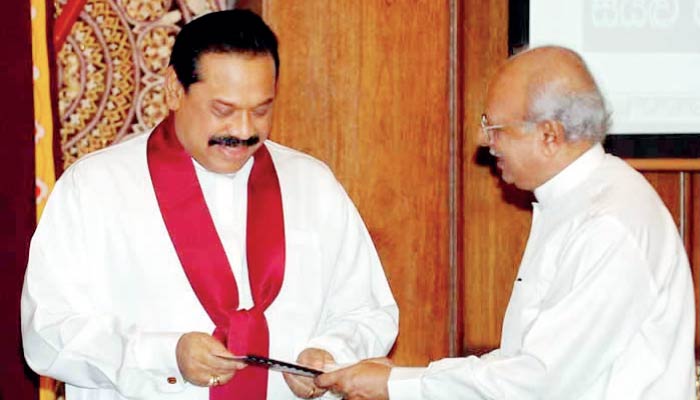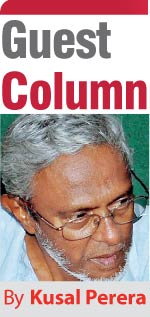Tuesday Jan 13, 2026
Tuesday Jan 13, 2026
Wednesday, 9 August 2023 00:35 - - {{hitsCtrl.values.hits}}

MR’s idea of an APRC was to have an all-party consensus on a “homegrown” political solution, he could offer the LTTE leadership once the military “pushes them to the wall”
|
 There are now “city talks” about all-party discussions convened at the Presidential Secretariat to discuss, reconciliation and to find answers to the Tamil National Question. These discussions will not serve any useful purpose, as long as mainstream political parties refrain from discussing these issues at length and in depth within their own organisations to begin with.
There are now “city talks” about all-party discussions convened at the Presidential Secretariat to discuss, reconciliation and to find answers to the Tamil National Question. These discussions will not serve any useful purpose, as long as mainstream political parties refrain from discussing these issues at length and in depth within their own organisations to begin with.
Every political leader and that includes Tamil and Muslim leaders too, who sat at this discussion and in all other previous discussions as well, sat without any mandate from their party membership (if there is) for what they stood and argued for. Let me therefore have this on record here. The Ceylon Teachers’ Union (CTU) then led by two committed trade union activists H.N. Fernando and Chitral Perera campaigned among its membership, then about 25 to 30% of the hundred thousand plus teachers for a resolution to be adopted at the Trincomalee Annual Delegates’ Conference (ADC) in 1978 that said the CTU as a teachers’ trade union in a multi-cultural, multi religious and a bi-lingual society, accepts “the right to self-determination of Tamil People”.
This resolution was duly adopted without division. Three and a half decades later the most, majority of the present 240,000 plus teachers have turned out to be extremely chauvinistic and backs any Sinhala-Buddhist racist campaign. They were shamelessly conspicuous in how they ill-treated and ridiculed Muslim children and Muslim teachers in their schools after the Easter tragedy.
Most professions are that. They have grown to be such in a political context mainstream political parties have for over 75 years been advocating, promoting, and legislating for Sinhala Buddhist dominance of the State. Political campaigns at every election had promises for the majority ethno-religious polity at the expense of the minorities. A dominant Sinhala-Buddhist social psyche created over 75 plus years and through four generations as “official dogma” by the two mainstream political parties along with their affiliations and alliances, have by now established this whole State as a wholly Sinhala Buddhist State.
What more proof would one need to accept this Sri Lankan State as a Sinhala Buddhist State than, (i) the arrest and indicting of a Muslim woman in Hasalaka for wearing a dress with a motif that law enforcement officers claimed was the Buddhist Dharmachakra and that insulted Buddhism (ii) ICCPR Act being used by law enforcement agencies for exactly the opposite of what it was enacted for – used against those who stand for ethno-religious amity claiming they insult Buddhism (iii) framing Dr. Shafi Shihabdeen for allegedly performing over 4,000 sterilisation surgeries on Sinhala Buddhist mothers with fake evidence (iv) enforcing the malicious decision of the Gotabaya Rajapaksa government to ban burials for COVID related deaths against Muslim deaths on arbitrary decisions made by hospital staff?
|
This social mindset in the South is now deep rooted. Among the Sinhala-Buddhist majority, it is now taken for granted the island nation is theirs. It is that mindset of the Sinhala-Buddhist that was given vent when General Sarath Fonseka as the Commanding Officer of the military fighting the war in the North, told the Canadian media, Sri Lanka is the country of Sinhala-Buddhists, and all minorities should know it and therefore should live as minorities. The same is said by the other “Sarath” former Minister of Public Security, Rtd. Rear Admiral Weerasekera.
I do not think, these political leaders in the Sinhala South sit at these discussions with any intention of finding an amiable resolution to the decades-old Tamil national question created by their racist grandfathers. All through past decades at every negotiating table and in every “All Party Conference” (APC) whether in Colombo or in Thimphu, for the Sinhala representation the major issue had been “how not to agree”.
Except for one rare instance it had always been re-inventing the same wheel. Same topics, same arguments, and same political parties at times as fractured groups though with generational changes in persons. Once it was Uncle JR. Now it is nephew Wickremesinghe. Once it was Dad Kumar and now it is son Gajendra. Then it was Senior Thondaman. Now it is grandson Thondaman.
That rare exception was certainly an accident. It remains the best outcome of any APC to date, and an opportunity that should have been grabbed by both Sinhala and Tamil leaders but was silently shelved. This APC was convened in 2006 by President Mahinda Rajapaksa (MR). At the second APC sessions on 11 July 2006 MR decided to have a permanent “representative committee” and established the All Party Representative Committee (APRC) requesting political parties to nominate a permanent representative. His explanation to have a permanent APRC was quite logical. These discussions would lose their continuity if participants kept changing, he said. He also appointed an “Expert Committee” to support the APRC with its formulations.
UNP did not accept the invitation to the APC as the breakaway group led by Karu Jayasuriya then in the Rajapaksa government was also participating as the UNP (Democratic) group. The TNA was not invited to the APC. When I asked MR why he did not invite the TNA, his explanation was, there is no point in having them in discussions when the South is not in agreement on power sharing. His plan he said, is to have the South agree on a solution and then to negotiate that with the TNA.
The JVP initially sat in the APRC, but left the APRC on the flimsy excuse they do not want an “expert committee” to tell them what they should accept as a solution. They did not want to sit in the discussions and expose themselves as Sinhala racists, opposing any form of power sharing.
MR allowed the APRC to pursue a “homegrown” solution with a new Constitution while the war continued, for few reasons of his own. He wanted to impress New Delhi, he is not in discussion with the LTTE, as previous governments did, but is serious about finding a permanent solution to the Tamil question. He also wanted to show the Sinhala South, he is the final decision maker and not the LTTE. He also believed the “Kobbekaduwa theory”. Late Denzil Kobbekaduwa is quoted by many as saying “the military can only push the armed Tamil rebels to the wall and force them to agree for negotiations. It is the political leadership that has to finally settle the conflict, as it is essentially a political conflict.” MR’s idea of an APRC was to have an all-party consensus on a “homegrown” political solution, he could offer the LTTE leadership once the military “pushes them to the wall”.
Almost three years later in May 2009, MR the politician could shift gear to go on his more comfortable journey as the “war winning” Head of State, when the military wiped out the LTTE en masse. Thereafter he had no interest in the APRC that concluded its work and as Chairperson of the APRC then Minister and Sama Samaja leader Prof. Tissa Vitharana handed him the “Final Report” of the APRC in July 2010. The first year anniversary of the “victorious war” held in grand style by then, President Rajapaksa simply shelved it and never spoke about it.
Timidity of this Sama Samaja leader was also evident, when he too left the APRC Final Report hidden after all the pains he himself endured in formulating it. He had the right to publish the Final Report immediately after handing it over to President Rajapaksa. But he had not given copies of the Final Report even to the members of the APRC. He was also drowned in the glory of the war victory celebrated by the Rajapaksas.
While all that is history of a serious effort made 13 years ago in formulating a homegrown solution to the Tamil National Question, the APRC Final Report remains valid to date to be used as a base for public discourse. This is a very comprehensive draft document that contains 22 Chapters and covers everything a Constitution needs to include. It provides for power sharing beyond 13A but in no way is it an extension of the 13A. It has a completely new and a consensual approach in devolving power and has no “concurrent list” of shared subjects as at present to make power sharing ambiguous. It also has “Community Councils” for Indian origin Tamils and Muslims outside North and East. Parliament proposed in it is a bi-cameral parliament with a Senate having 63 members. It has skilfully avoided the contentious issue of a “Unitary State”.
Most importantly as MR planned, with this APRC Final Report he had managed to gather total consensus in the South. The list of political parties that had consented to the Final Report of the APRC includes all Sinhala-Buddhist campaigners in the South; SLFP, MEP, LSSP, CP, the UNP (Democratic) group led by the confirmed Sinhala-Buddhist leader Karu Jayasuriya and then undivided JHU with Champika Ranawaka, Gammanpila and Athuraliye Rathana thero together. With them the others included SLMC, CWC, Douglas Devananda’s EPDP and Mano Ganesan then as WPF.
What President Wickremesinghe should therefore do is to request the PM of his Government Dinesh Gunawardene who is also a party to this APRC Final Report to table it in Parliament and make it public officially for a serious social dialogue. That would avoid yet another round of futile all-party discussions but remind most they have already agreed to devolution of power with a new Republican Constitution.